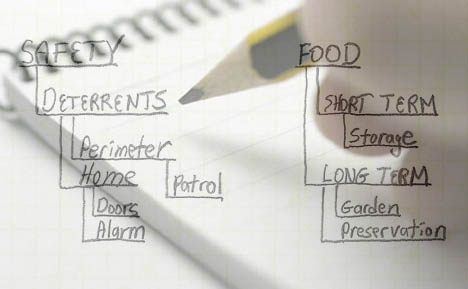Emergency Preparedness Planning 101

The reasons that people and preppers go about preparing, are many and wide ranging (What Are You Prepping For?). Be it for surviving after an economic collapse or an EMP blast that takes down the power grid, the planning and preparation can be become unwieldy and overwhelming, especially while considering a complete social breakdown and the requirements to keep one’s self and family safe, sustained, and viable into the future.
The best way to go about disaster planning is to break it all down into an organized list and sub-lists of areas or categories that you need to address, starting from the basic high-level requirements all the way down to the finer details…
With you (or your family and group) at the top of the list, think of a list of categories organized similar to an organizational chart… the org charts of the type we’ve all seen before.
First come up with the major areas or categories that are of the most importance to your survival, your needs and well being. Write them down. Second, further define the categories and break them each down into more detail. This can all be done in lists or charts, however it works best for you. One way is to have each page with a top level item followed by the immediate subsets, while the next page may be a subset with its own list of sub-subsets, etc.
They may not be the same for everyone, but here are some ideas for the top row of the org chart to get you going. These higher category priorities of emergency preparedness should be considered somewhat equal in overall general importance, as they are all needed to keep your survival ‘system’ going.
SAFETY
Others will want what you have. You will need protection. What will the rule of law become after a breakdown.. Break this category down into subsets and scenarios. Things you’ll need. OPSEC holes to plug, etc. Your home, security, perimeter, prevention, deterrents, alarms, patrols, weapons, etc.
FOOD
Consider your short and long term plans for food and storage. What and how much to store now, and what-and-how to procure later. Gardening, hunting, trading, equipment, know-how, sustainability, food groups, edibility of indigenous plants, etc.
WATER
Similar to food, how much will you store on-hand and how will you procure more later. Filtering and purifying. Transporting. Proximity to sources. Rainwater capture. Irrigation.
ENERGY
Will everything you do be the result of manual labor, or will you enable alternative energy sources… Short term solutions, generator, fuel. Long term solutions, solar, battery banks, inverters, etc. Knowledge of electricity. Tools and equipment. Adaptability of tools/appliances to energy source.
FINANCES OR EQUIVALENT
Short and long term solutions including cash on hand, precious metals, other tangible assets that will store wealth for trade, barter or holdover to next financial system.
HEALTH
First aid, supplies, training, knowledge, know-how, prevention, medications, natural solutions, where to go or what to do for major emergencies in a collapsed society… Infections can kill.
SITUATIONAL AWARENESS PLAN
Understanding the risks and threat assessment based on current events and knowledge, is paramount to success. Creating action plans for what to do when certain thresholds are crossed. Bug-in, bug-out. How, what, when, where.
INFRASTRUCTURE
Successful systems require functional infrastructure. Consider your home/shelter, distribution, transportation, sanitation, etc.
COMMUNICATIONS
Good communications is essential for good decision making. Consider the information that you will need to gather from near and/or afar, your personnel, the equipment, some of it specialized for particular needs… receive-only versus 2-way radio communications, etc.
These top level categories each will easily contain many sub-categories right beneath them. Each of those sub-categories will in turn spider out into their own lists. The first step towards emergency preparedness is the initial planning. Think long and hard about the top level categories. The list above is simply a guide, certainly not complete with definitions and subsets. The idea is to begin with the most important areas and then work down from there. Brainstorm. Get out your pencil and some paper. You will need an eraser…
Among the highest priorities for survival is safe drinking water.
AlexaPure Pro Gravity-Powered Water Filtration
Tested against NSF/ANSI 53, NSF/ANSI 42

